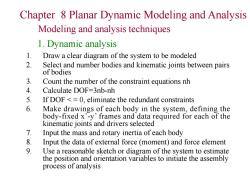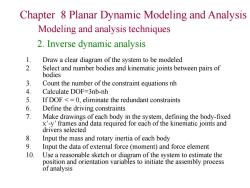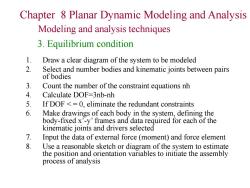上海交通大学:《复杂系统动力学计算机辅助分析》课程教学资源_Chapter 8_Planar Dynamic Modeling and Analysis

Chapter 8 Planar Dynamic Modeling and Analysis Modeling and analysis techniques 1.Dynamic analysis 1. Draw a clear diagram of the system to be modeled 2. Select and number bodies and kinematic joints between pairs of bodies 3. Count the number of the constraint equations nh 4. Calculate DOF=3nb-nh 5. If DOF<=0,eliminate the redundant constraints 6. Make drawings of each body in the system,defining the body-fixed x'-y'frames and data required for each of the kinematic joints and drivers selected 7. Input the mass and rotary inertia of each body 8. Input the data of external force(moment)and force element 9. Use a reasonable sketch or diagram of the system to estimate the position and orientation variables to initiate the assembly process of analysis
Chapter 8 Planar Dynamic Modeling and Analysis 1. Draw a clear diagram of the system to be modeled 2. Select and number bodies and kinematic joints between pairs of bodies 3. Count the number of the constraint equations nh 4. Calculate DOF=3nb-nh 5. If DOF < = 0, eliminate the redundant constraints 6. Make drawings of each body in the system, defining the body-fixed x’-y’ frames and data required for each of the kinematic joints and drivers selected 7. Input the mass and rotary inertia of each body 8. Input the data of external force (moment) and force element 9. Use a reasonable sketch or diagram of the system to estimate the position and orientation variables to initiate the assembly process of analysis Modeling and analysis techniques 1. Dynamic analysis

Chapter 8 Planar Dynamic Modeling and Analysis Modeling and analysis techniques 2.Inverse dynamic analysis 1. Draw a clear diagram of the system to be modeled 2. Select and number bodies and kinematic joints between pairs of bodies 3. Count the number of the constraint equations nh 4. Calculate DOF=3nb-nh 5. If DOF <=0,eliminate the redundant constraints 6. Define the driving constraints 7. Make drawings of each body in the system,defining the body-fixed x'-y'frames and data required for each of the kinematic joints and drivers selected 8. Input the mass and rotary inertia of each body 9. Input the data of external force(moment)and force element 10 Use a reasonable sketch or diagram of the system to estimate the position and orientation variables to initiate the assembly process of analysis
Chapter 8 Planar Dynamic Modeling and Analysis Modeling and analysis techniques 2. Inverse dynamic analysis 1. Draw a clear diagram of the system to be modeled 2. Select and number bodies and kinematic joints between pairs of bodies 3. Count the number of the constraint equations nh 4. Calculate DOF=3nb-nh 5. If DOF < = 0, eliminate the redundant constraints 6. Define the driving constraints 7. Make drawings of each body in the system, defining the body-fixed x’-y’ frames and data required for each of the kinematic joints and drivers selected 8. Input the mass and rotary inertia of each body 9. Input the data of external force (moment) and force element 10. Use a reasonable sketch or diagram of the system to estimate the position and orientation variables to initiate the assembly process of analysis

Chapter 8 Planar Dynamic Modeling and Analysis Modeling and analysis techniques 3.Equilibrium condition 1. Draw a clear diagram of the system to be modeled 2. Select and number bodies and kinematic joints between pairs of bodies 3. Count the number of the constraint equations nh 4. Calculate DOF=3nb-nh 5. If DOF <=0,eliminate the redundant constraints 6. Make drawings of each body in the system,defining the body-fixed x'-y'frames and data required for each of the kinematic joints and drivers selected 7. Input the data of external force(moment)and force element 8. Use a reasonable sketch or diagram of the system to estimate the position and orientation variables to initiate the assembly process of analysis
Chapter 8 Planar Dynamic Modeling and Analysis Modeling and analysis techniques 3. Equilibrium condition 1. Draw a clear diagram of the system to be modeled 2. Select and number bodies and kinematic joints between pairs of bodies 3. Count the number of the constraint equations nh 4. Calculate DOF=3nb-nh 5. If DOF < = 0, eliminate the redundant constraints 6. Make drawings of each body in the system, defining the body-fixed x’-y’ frames and data required for each of the kinematic joints and drivers selected 7. Input the data of external force (moment) and force element 8. Use a reasonable sketch or diagram of the system to estimate the position and orientation variables to initiate the assembly process of analysis
按次数下载不扣除下载券;
注册用户24小时内重复下载只扣除一次;
顺序:VIP每日次数-->可用次数-->下载券;
- 上海交通大学:《复杂系统动力学计算机辅助分析》课程教学资源_Chapter 7_chap7-Numerical Methods in Dynamics.ppt
- 上海交通大学:《复杂系统动力学计算机辅助分析》课程教学资源_Chapter 6_Char6.6 Constraint reaction forces.ppt
- 上海交通大学:《复杂系统动力学计算机辅助分析》课程教学资源_Chapter 6_Char6.5 Equilibrium Problem.ppt
- 上海交通大学:《复杂系统动力学计算机辅助分析》课程教学资源_Chapter 6_Char6.4 Inverse Dynamics.ppt
- 上海交通大学:《复杂系统动力学计算机辅助分析》课程教学资源_Chapter 6_Char6.3 Equations of motion of constrained planar.ppt
- 上海交通大学:《复杂系统动力学计算机辅助分析》课程教学资源_Chapter 6_Char6.2 Virtual work and generalized force.ppt
- 上海交通大学:《复杂系统动力学计算机辅助分析》课程教学资源_Chapter 6_Char6.2 Virtual work and generalized force.ppt
- 上海交通大学:《复杂系统动力学计算机辅助分析》课程教学资源_Chapter 6_Char6.1-Equations of motion of a planar rigid body.ppt
- 上海交通大学:《复杂系统动力学计算机辅助分析》课程教学资源_Chapter 5_Modeling for Example2.doc
- 上海交通大学:《复杂系统动力学计算机辅助分析》课程教学资源_Chapter 5_Modeling for Example 5.doc
- 上海交通大学:《复杂系统动力学计算机辅助分析》课程教学资源_Chapter 5_Modeling for Example 4.doc
- 上海交通大学:《复杂系统动力学计算机辅助分析》课程教学资源_Chapter 5_Planar Kinematic Modeling and Analysis.ppt
- 上海交通大学:《复杂系统动力学计算机辅助分析》课程教学资源_Chapter 4_Flow chart for kinematics.doc
- 上海交通大学:《复杂系统动力学计算机辅助分析》课程教学资源_Chapter 4_Char4-Numerical methods.ppt
- 上海交通大学:《复杂系统动力学计算机辅助分析》课程教学资源_Chapter 3_CHAP3.7-singularity.ppt
- 上海交通大学:《复杂系统动力学计算机辅助分析》课程教学资源_Chapter 3_CHAP3.6-Position, velocity and acceleration analysis_1.ppt
- 上海交通大学:《复杂系统动力学计算机辅助分析》课程教学资源_Chapter 3_CHAP3.6-Position, velocity and acceleration analysis.ppt
- 上海交通大学:《复杂系统动力学计算机辅助分析》课程教学资源_Chapter 3_CHAP3.5-Driving constraint.ppt
- 上海交通大学:《复杂系统动力学计算机辅助分析》课程教学资源_Chapter 3_CHAP3.4-Gears.ppt
- 上海交通大学:《复杂系统动力学计算机辅助分析》课程教学资源_Chapter 3_CHAP3.3-Relative Constraint.ppt
- 上海交通大学:《复杂系统动力学计算机辅助分析》课程教学资源_Chapter 8_Modeling for Example 4.doc
- 上海交通大学:《复杂系统动力学计算机辅助分析》课程教学资源_Chapter 8_Modeling for Example1.doc
- 上海交通大学:《复杂系统动力学计算机辅助分析》课程教学资源_Chapter 8_Modeling for Example2.doc
- 上海交通大学:《复杂系统动力学计算机辅助分析》课程教学资源_动力学上机_双摆动力学仿真说明.doc
- 上海交通大学:《复杂系统动力学计算机辅助分析》课程教学资源_动力学上机_双摆动力学逆问题说明.doc
- 上海交通大学:《复杂系统动力学计算机辅助分析》课程教学资源_动力学上机_静平衡条件说明.doc
- 上海交通大学:《复杂系统动力学计算机辅助分析》课程教学资源_动力学附加题.doc
- 上海交通大学:《复杂系统动力学计算机辅助分析》课程教学资源_双摆动力学仿真说明.doc
- 上海交通大学:《复杂系统动力学计算机辅助分析》课程教学资源_双摆动力学逆问题说明.doc
- 上海交通大学:《复杂系统动力学计算机辅助分析》课程教学资源_运动学上机_运动学计算流程图.doc
- 上海交通大学:《复杂系统动力学计算机辅助分析》课程教学资源_运动学计算流程图.doc
- 上海交通大学:《复杂系统动力学计算机辅助分析》课程教学资源_静平衡条件说明.doc
- 上海交通大学:《人体生物力学》课程教学资源(讲义)人体生物力学概论(梁夫友).pdf
- 上海交通大学:《人体生物力学》课程教学资源(讲义)心血管生物力学及其在疾病诊疗方面的应用.pdf
- 上海交通大学:《人体生物力学》课程教学资源(讲义)运动生物力学及组织损伤机理、计算机辅助手术.pdf
- 上海交通大学:《人体生物力学》课程教学资源(讲义)生物力学的发展前景.pdf
- 《力学改变生活》课程教学资源(文献资料)The First Sounds of Merging Black Holes.pdf
- 《力学改变生活》课程教学资源(文献资料)Observation of Gravitational Waves from a Binary Black Hole Merger.pdf
- 上海交通大学:《材料热力学》教学资源_2018 lecture 4 second law II.pdf
- 上海交通大学:《材料热力学》教学资源_2018 lecture 5 property relation.pdf
